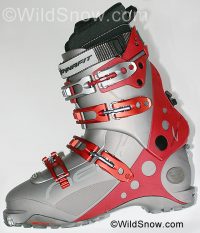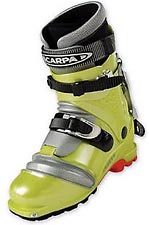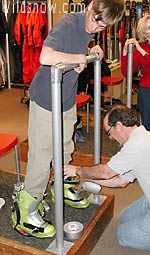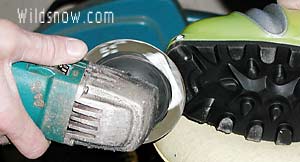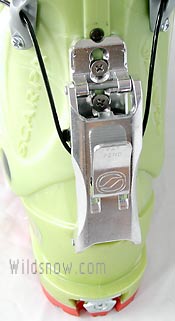Shop for Garmont ski boots here.
| Garmont Megaride is one of the best blends of performance and touring ease you can get in a backcountry skiing boot. Please click image for massive enlargement. |
This year’s Garmont Megaride is significantly improved over last year. And how does it compare to the Dynafit Aero Freeride? Read on.
The biggest performance difference I noticed is this year’s Megaride has a slightly stiffer tongue — good news for anyone seeking a beefy AT boot. Another major change is a redesigned lean-lock lever that appears to be more protected from rock and ski damage. And for you hikers out there, that pesky fourth buckle (down front) has been relocated in the correct position so it doesn’t get ripped off the first time you encounter a scree field (though the buckle anchor might need the lower notches ground off). And, I might be imagining this, but the famous G-fit thermo liner seems even nicer than last year’s, with a high density area around the upper cuff and upper tongue — more alpine like all the time! In all, this appears to be a mature iteration of the Mega: some bugs fixed, a few improvements. Nice!
So, oh ye blog readers, thanks to Garmont and Life-Link, here is the comparo ye have requested between Garmont and Dynafit’s biggest Dynafit compatible boots: (for Aero 314 length shell, Mega 320, the best shell sizes for my feet):
Weight (liners are essentially the same weight, at 8 oz, 226 g):
– Aero SHELL, 63.7 oz, 1806 g
– Mega SHELL, 51.4 oz, 1456 g
Lean Lock:
– Aero operated by twisting knob, might be difficult, may freeze easier. Very easy to add forward lean to exact personal desire (boot fitter drills one small hole). Only has one factory forward lean setting.
– Mega operated by flipping catch that seems good (can be seen in enlarged photo), but has two positions so you get to guess which forward lean setting you’re on. Fine tuning forward lean requires MIG welder and Santa’s workshop.
Beef:
-Aero is definitely stiffer in all directions than the Mega (that’s why it weighs quite a bit more, could be too stiff for some users, but is almost an alpine boot).
-Mega is still a good compromise between alpine and randonnee flex and will remain my long distance touring boot of choice.
Ease of use:
-Aero has non-hinged tongue that makes entry and exit more difficult, and no touring catches on upper buckles.
-Mega has hinged tongue, and nice touring catches so you can leave buckles loose but not flapping around while you’re backcountry skiing.
-Aero has the cool new Dynafit toe sockets with lead-in notch. It works and does make binding entry slightly easier.
-Mega has the original style toe sockets, which work fine (though I like the new ones on the Aero).
Fit:
-Aero is a larger volume boot with a flatter footboard, though it still has enough built-in arch to drive a boot fitter crazy.
-Mega has noticeably less volume, and a higher arch, though it’s still flatter than a Scarpa.
-Aero has no cuff alignment (cant) rivet, boot fitter has to swap one in from a dumpster boot in Santa’s workshop.
-Mega has alignment rivet.
Shell height:
Effectively the same at the rear, though the Aero has a rear spoiler that a boot fitter can either remove or raise. Mega has a small spoiler that can be removed, but would not lend itself to raising up. The Mega liner is slightly higher, and has a slightly more alpine-like transition zone from cuff to liner — a consideration of you tend to get calf or shine bite.
Summary:
Both these fine boots both represent state-of-art randonnee shoe design. The Megaride is obviously a terrific compromise between weight and performance. The Aero trends over to the performance side, while still being significantly lighter than a full-on alpine boot. My shopping stress level is low, as I get to ski both boots this year and don’t have to choose. If you’re shopping angst is rising, consider fit first and buy the boot with volume and arch appropriate for your feet. After that, buy the Aero if you’ll be spending much time on ski lifts, or want what is easily the stiffest Dynafit compatible backcountry skiing boot out there. Conversely, if you are looking for touring efficiency mixed with beef, the Megaride is one of the best boots of that sort I’ve ever used. Shop for Garmont ski boots here.
More info from Scott’s website (parent corp of Garmont).
WildSnow.com publisher emeritus and founder Lou (Louis Dawson) has a 50+ years career in climbing, backcountry skiing and ski mountaineering. He was the first person in history to ski down all 54 Colorado 14,000-foot peaks, has authored numerous books about about backcountry skiing, and has skied from the summit of Denali in Alaska, North America’s highest mountain.


